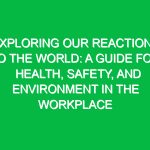Introduction
In today’s rapidly changing work environment, ensuring the health, safety, and environmental (HSE) well-being of employees is paramount. One effective approach to enhancing workplace safety is through the implementation of a “tips ladder.” This concept serves as a structured method for identifying and addressing safety concerns, allowing organizations to foster a culture of safety and responsibility. A tips ladder consists of a series of actionable steps designed to elevate workplace safety, ultimately leading to a healthier work environment. In this article, we will explore the essential elements of a tips ladder, focusing on their relevance and application within the HSE domain.
Understanding the Tips Ladder in HSE
The tips ladder is an organized framework that categorizes safety tips according to their priority and effectiveness. Each step on the ladder represents a different level of safety measures, from basic preventive actions to more advanced safety protocols. This structured approach not only simplifies the process of improving safety but also ensures that all employees understand their roles in maintaining a safe workplace.
- Step 1: Awareness – Recognizing potential hazards in the workplace.
- Step 2: Training – Providing employees with the necessary skills and knowledge.
- Step 3: Reporting – Encouraging open communication about safety concerns.
- Step 4: Equipment Maintenance – Ensuring that all safety equipment is in proper working order.
- Step 5: Emergency Preparedness – Developing and practicing emergency response plans.
Each of these steps plays a crucial role in the overall safety framework and contributes to a culture of health and safety within the workplace.
Essential Tips for Each Step of the Tips Ladder
Step 1: Awareness
Awareness is the foundation of workplace safety. Employees must be cognizant of their surroundings and understand the potential hazards present in their work environment. This step involves conducting thorough risk assessments and identifying areas that may pose safety risks.
To enhance awareness, organizations can implement regular safety audits and inspections. For example, a manufacturing facility might conduct weekly walk-throughs to identify any machinery that could pose a risk to employees. Additionally, promoting a safety-first mindset through safety campaigns and visible reminders can reinforce awareness among staff.
Step 2: Training
Training is essential for ensuring that employees have the knowledge and skills to operate safely. This step involves developing comprehensive training programs tailored to the specific hazards of the workplace.
For instance, if your organization deals with hazardous materials, it is crucial to provide employees with training on proper handling and disposal techniques. Real-life scenarios can be integrated into training sessions to make them more relatable and impactful.
Moreover, the effectiveness of training can be evaluated through assessments and practical demonstrations, ensuring that employees are equipped to handle various situations safely.
Step 3: Reporting
Encouraging open communication about safety concerns is vital for maintaining a safe workplace. Employees should feel empowered to report hazards without fear of retribution.
Establishing a clear reporting system, such as a digital platform for submitting safety concerns, can streamline this process. Additionally, creating an anonymous reporting option can encourage more employees to voice their concerns.
In a real-world example, a construction company implemented a safety reporting hotline that allowed workers to report near-misses and unsafe conditions. As a result, the company was able to address issues proactively and reduce incident rates significantly.
Step 4: Equipment Maintenance
Proper maintenance of safety equipment is critical for reducing workplace accidents. This step involves regular inspections and servicing of all safety gear, machinery, and tools.
Organizations should establish a maintenance schedule to ensure that all equipment is functioning optimally. For instance, a facility that relies on fire extinguishers must conduct monthly checks to ensure they are charged and accessible.
Moreover, employees should be trained on how to check and maintain their personal protective equipment (PPE) properly. Regular training sessions can reinforce the importance of equipment maintenance and ensure that employees are vigilant in their responsibilities.
Step 5: Emergency Preparedness
Emergency preparedness is essential for minimizing the impact of unforeseen incidents. This step involves developing, implementing, and regularly practicing emergency response plans.
Organizations should conduct drills for various scenarios, such as fire evacuations or chemical spills. These drills not only prepare employees for emergencies but also provide an opportunity to identify gaps in the response plan.
In addition, clear communication regarding emergency procedures should be accessible to all employees. This could include posting evacuation routes and emergency contacts in visible areas throughout the workplace.
Potential Hazards and Risks
Understanding the potential hazards and risks associated with workplace safety is crucial for developing an effective tips ladder. Common hazards may include:
- Physical Hazards: Machinery, slips, trips, and falls are prevalent in many industries.
- Chemical Hazards: Exposure to toxic substances can pose significant health risks.
- Biological Hazards: Bacteria, viruses, and other pathogens can be particularly concerning in healthcare settings.
- Ergonomic Hazards: Poor workstation design can lead to musculoskeletal injuries.
By identifying and addressing these hazards at each step of the tips ladder, organizations can create a safer work environment for all employees.
Regulations and Standards in HSE
Various regulations and standards govern workplace health and safety, and it is essential for organizations to comply with these requirements. In the United States, the Occupational Safety and Health Administration (OSHA) sets forth guidelines to ensure safe working conditions.
Under OSHA regulations, employers are required to provide a workplace free from recognized hazards. This includes conducting regular risk assessments and implementing safety measures relevant to the risks identified.
Additionally, organizations may also need to comply with industry-specific standards, such as those established by the National Fire Protection Association (NFPA) for fire safety or the Environmental Protection Agency (EPA) for environmental regulations.
Understanding these regulations not only helps organizations maintain compliance but also reinforces their commitment to employee safety and well-being.
Conclusion
In conclusion, the tips ladder serves as an invaluable tool for organizations striving to enhance workplace health, safety, and environmental sustainability. By following the structured approach outlined in the tips ladder—focusing on awareness, training, reporting, equipment maintenance, and emergency preparedness—companies can create a safer work environment for their employees.
The importance of prioritizing health and safety cannot be overstated. A safe workplace not only protects employees but also boosts morale, productivity, and overall organizational success. As we move forward, organizations are encouraged to reflect on their safety practices and consider how the tips ladder can be integrated into their existing HSE frameworks.
Ultimately, fostering a culture of safety requires commitment from every level of the organization, and implementing a tips ladder is a significant step toward unlocking safety for a healthier workplace.


